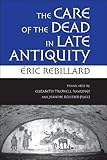The care of the dead in late antiquity / Éric Rebillard ; translated by Elizabeth Trapnell Rawlings and Jeanine Routier-Pucci.
Material type: TextLanguage: English Original language: French Series: Cornell studies in classical philology ; 59.Publication details: Ithaca : Cornell University Press, 2009.Description: 1 online resource (xiii, 224 pages)Content type:
TextLanguage: English Original language: French Series: Cornell studies in classical philology ; 59.Publication details: Ithaca : Cornell University Press, 2009.Description: 1 online resource (xiii, 224 pages)Content type: - 9780801459160
- 0801459168
- Religion et sépulture. English
- Death -- Religious aspects -- Christianity
- Funeral rites and ceremonies, Ancient -- Rome -- Religious aspects
- Funeral rites and ceremonies, Ancient -- Religious aspects
- Mort -- Aspect religieux -- Christianisme
- Funérailles -- Rites et cérémonies -- Histoire -- Jusqu'à 500 -- Rome -- Aspect religieux
- Funérailles -- Rites et cérémonies -- Histoire -- Jusqu'à 500 -- Aspect religieux
- HISTORY -- Ancient -- Rome
- RELIGION -- Christian Rituals & Practice -- Sacraments
- RELIGION -- Christianity -- General
- Death -- Religious aspects -- Christianity
- Rome (Empire)
- Bestattung
- Bestattungsritus
- Spätantike
- Frühchristentum
- Römisches Reich
- Religieuze gebruiken
- Dood
- Begrafenissen
- 265/.850937 22
- BT826 .R4313 2009eb
- online - EBSCO
- 11.51
- BS 3450
- NH 9450
- 6,12
- digitized 2010 HathiTrust Digital Library committed to preserve
| Item type | Current library | Call number | URL | Status | Notes | Barcode | |
|---|---|---|---|---|---|---|---|
 eBook
eBook
|
Biblioteca "Angelicum" Pont. Univ. S.Tommaso d'Aquino Nuvola online | online - EBSCO (Browse shelf(Opens below)) | Online access | Not for loan (Accesso limitato) | Accesso per gli utenti autorizzati / Access for authorized users | (ebsco)673740 |
Browsing Biblioteca "Angelicum" Pont. Univ. S.Tommaso d'Aquino shelves, Shelving location: Nuvola online Close shelf browser (Hides shelf browser)
Includes bibliographical references (pages 179-212) and index.
The problem of the origins : Christian burial in Rome and Carthage -- Burial and religious identity : religious groups and collective burial -- Voluntary associations and collective burial : the church, Christians, and the Collegia -- Violation of tombs and impiety : funerary practices and religious beliefs -- Christian piety and burial duty : from the duty to bury the dead to the organization of burial for the poor -- Christian funerals and funerals of Christians : the church and the death ritual in late antiquity -- The church, Christians, and the dead : commemoration of the dead in late antiquity.
Use copy Restrictions unspecified star MiAaHDL
Electronic reproduction. [Place of publication not identified] : HathiTrust Digital Library, 2010. MiAaHDL
Master and use copy. Digital master created according to Benchmark for Faithful Digital Reproductions of Monographs and Serials, Version 1. Digital Library Federation, December 2002. MiAaHDL
http://purl.oclc.org/DLF/benchrepro0212
digitized 2010 HathiTrust Digital Library committed to preserve pda MiAaHDL
Print version record.
In this provocative book Éric Rebillard challenges many long-held assumptions about early Christian burial customs. For decades scholars of early Christianity have argued that the Church owned and operated burial grounds for Christians as early as the third century. Through a careful reading of primary sources including legal codes, theological works, epigraphical inscriptions, and sermons, Rebillard shows that there is little evidence to suggest that Christians occupied exclusive or isolated burial grounds in this early period. In fact, as late as the fourth and fifth centuries the Church did not impose on the faithful specific rituals for laying the dead to rest. In the preparation of Christians for burial, it was usually next of kin and not representatives of the Church who were responsible for what form of rite would be celebrated, and evidence from inscriptions and tombstones shows that for the most part Christians didn't separate themselves from non-Christians when burying their dead. According to Rebillard it would not be until the early Middle Ages that the Church gained control over burial practices and that "Christian cemeteries" became common. In this translation of Religion et Sépulture: L'église, les vivants et les morts dans l'Antiquité tardive, Rebillard fundamentally changes our understanding of early Christianity. The Care of the Dead in Late Antiquity will force scholars of the period to rethink their assumptions about early Christians as separate from their pagan contemporaries in daily life and ritual practice.
In English.









